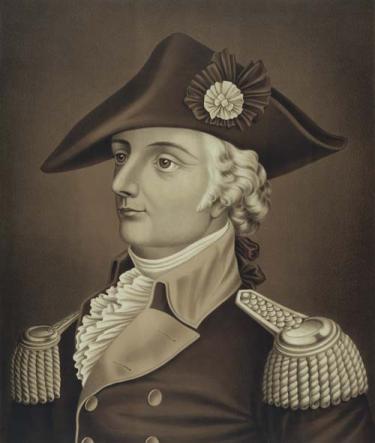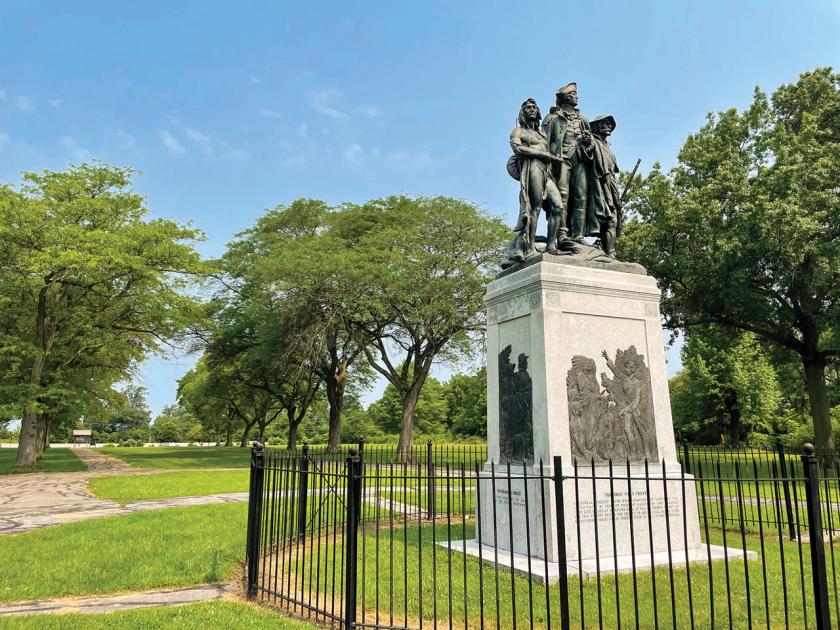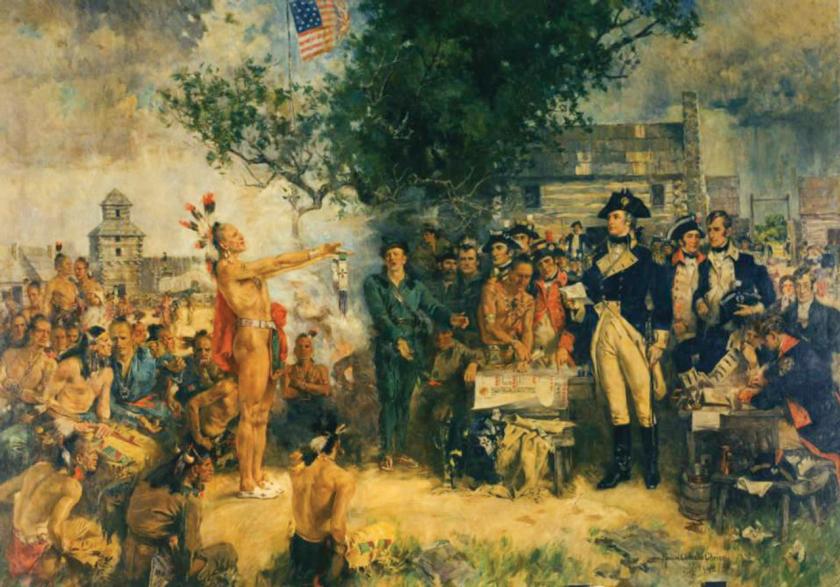
"Charge of the Dragoons at Fallen Timbers," painted by R. T. Zogbaum for Harper's Magazine,
The conclusion of the American Revolution significantly altered the landscape of North America. In the 1783 Treaty of Paris that ended the conflict, Great Britain ceded territory stretching from the Allegheny Mountains west to the Mississippi River and south from the Great Lakes to the Gulf of Mexico. Native American tribes like the Shawnee, Miami and Delaware, many of them allies of the British, claimed this land as their own. Still, the British government in Canada hoped to maintain cordial relations with the tribes in the coveted Ohio River Valley, primarily due to the lucrative fur trade.
Between 1785 and 1787, the U.S. government negotiated treaties that steadily pushed tribes farther toward the Great Lakes. On July 13, 1787, Congress passed the Northwest Ordinance, creating a government for the Northwest Territory. The legislation outlined the process for creating new states, making white settlement inevitable and deepening the existing tension between Natives and the government.

In the spring and summer of 1790, the governor of the territory, Arthur St. Clair, traveled to Vincennes to make treaty overtures to tribes living along the Wabash River. When none responded, a frustrated St. Clair decided to initiate military operations. He instructed Brigadier General Josiah Harmar and the First American Regiment to march to Kekionga, the main Miami town, located where the St. Mary’s and St. Joseph’s Rivers converged to form the Maumee, and construct a fort.
Augmented by Kentucky and Pennsylvania militia, Harmar struck out from Fort Washington, outside Cincinnati, in late September. The Americans advanced in three columns, steadily moving north. On October 13, a captured Shawnee informed Harmar that the Miamis were evacuating their towns. Hoping to catch them before they fled, Harmar dispatched an advance guard under Colonel John Hardin. They arrived at Kekionga three days later, just a day ahead of the main body, to find it abandoned.
Acting on reports that the Miamis remained in the immediate vicinity, Harmar sent Hardin, along with a contingent of Regulars under Captain John Armstrong, northwest toward the Eel River. That afternoon, Miami warriors under Little Turtle ambushed the Americans near the river, sending them fleeing back to Harmar’s camp.
Little Turtle’s victory shifted the initiative to the Miami. The news shocked Harmar, who decided to give up the expedition and return to Fort Washington. He started south on October 21. That night, a scout left behind to monitor the Miamis reported that warriors had reoccupied Kekionga. Hoping to recover his fortunes and possibly surprise his foe, Harmar sent a force back under Major John Wyllys early on the morning of October 22.
Wyllys reached a ford along the Maumee opposite Kekionga later that day. Little Turtle and his Miamis, along with some Delaware, Sauk, Shawnee and Ottawa warriors, were indeed waiting for them. Once again, Little Turtle sprang an ambush. This time, the Americans put up a stiffer fight, and the engagement lasted for several hours. Eventually, the Americans broke off and withdrew to Harmar’s main column. Dejected, Harmar continued his retreat, arriving at Fort Washington on November 3.
The failed campaign shocked President George Washington’s administration. St. Clair, commissioned a major general, relieved Harmar. In March 1791, St. Clair and Washington began planning a new campaign. Following up on their success, Blue Jacket, a Shawnee chief, traveled to Detroit to confer with the British governor of Canada, Sir Guy Carleton. Blue Jacket pleaded for assistance, and although Carleton could not promise troops, he ordered munitions to be delivered to the tribes.
St. Clair planned to repeat Harmar’s expedition and adopted the objective of building a fort at Kekionga. The army left Fort Washington on September 8. To secure his supply line, St. Clair ordered the construction of Forts Hamilton and Jefferson as he trudged north. On the afternoon of November 3, St. Clair reached the banks of the Wabash River and bedded down for the night. Unbeknownst to the Americans, a force of more than 1,000 warriors under Blue Jacket and Little Turtle crept toward them in the darkness. The warrior formation resembled a half moon, designed to close off any potential line of retreat, and the Native forces struck before dawn on November 4. After several hours of fighting — an engagement known to history ignominiously as St. Clair’s Defeat — the remnants of the American army, well-less than half its original size, fled in horror back to Fort Jefferson.
Blue Jacket and Little Turtle’s triumph was the greatest defeat ever inflicted on the United States Army by a Native force. “O God, O God, he is worse than a murderer!” Washington raged against St. Clair upon receiving the news. “How can he answer to his country? The blood of the slain is upon him — the curse of widows and orphans — the curse of heaven!”

Washington and his Cabinet now faced the monumental task of rebuilding the army and, after careful thought, appointed Revolutionary War hero “Mad” Anthony Wayne to succeed St. Clair. Wayne received his commission of major general on March 5, 1792, and soon set out to rendezvous with his new command, the freshly authorized and expanded Legion of the United States, at Fort Fayette near Pittsburgh.
Wayne instilled a strict regimen of drill and discipline. The Legion departed for Cincinnati on April 30, 1793, arriving on May 6. Rather than occupy Fort Washington, Wayne established his men at a new camp at Hobson’s Choice on the Ohio River. On October 7, Wayne began a march into the land that saw the destruction of St. Clair’s army and the careers of his predecessors.
Aware of the mistakes of Harmar and St. Clair, Wayne determined not to fall into an ambush. He instructed his men to fortify their camps after each day’s march. Ten days into his advance, however, a band of Ottawa attacked and routed one of the Legion’s supply trains. This prompted Wayne to go into winter quarters. He ordered the construction of Fort Greeneville, named for his old friend, commander and Continental Army officer, Nathanael Greene. In December, Wayne sent Major Henry Burbeck to the Wabash River to occupy St. Clair’s battlefield, inter remains and build a fort later christened Recovery.
On July 28, 1794, Wayne and the Legion departed Fort Greenville. Rather than head to Kekionga, he charted a course to the north, then turned east toward the area known as the Grand Glaize, where the Auglaize River flowed into the Maumee. It was also the site of a large village. Wayne reached the Grand Glaize on August 8 and put his men to work constructing a new fort he named Defiance.
A week passed before Wayne marched out of Fort Defiance, heading northeast along the bank of the Maumee. On August 16, a flag of truce arrived from the warriors, asking Wayne to halt for 10 days until they could come down and meet with him. This delaying tactic allowed the tribes to assemble at Fort Miamis, constructed that spring by Lieutenant Colonel John Graves Simcoe, the lieutenant governor of Canada, near the Maumee Rapids.

Wayne elected to continue his march. Sensing that the warriors were close, he slowed his pace to allow his scouts time to survey his front. The Legion reached Roche de Boeuf, a giant rock outcropping in middle of the Maumee on August 18 and constructed Fort Deposit to house baggage in preparation for a final advance.
The Legion moved out at 5:00 a.m. on August 20, its two wings plunging into a forest thick with downed trees, earning the subsequent conflict the name the Battle of Fallen Timbers. Waiting for them was a force of Chippewa, Delaware, Mingo, Ottawa, Potawatomi and Wyandot.
The fighting started when Wayne’s advance guard stumbled upon some nervous warriors, who quickly gained the upper hand and pushed the Legion back toward the main line. As his men came stumbling back through the trees, Wayne deployed his light infantry and called up his artillery. Lieutenant William Henry Harrison, Wayne’s aide, admonished his commander not to ride too far ahead without issuing orders. Wayne thundered that his only order was to “[C]harge the damned rascals with the bayonet!”
As the warriors advanced, they began feeling for the Legion’s left, and Wayne sent troops to bolster that end of the line. Bitter fighting stabilized the line, and Wayne ordered a bayonet charge at trail arms. The right of Wayne’s line advanced at about the same time, pressing the warriors back from the Legion. Major William Campbell, the British commander at Fort Miamis, hoping to avoid conflict, refused the retreating warriors entry. Wayne led his men to the fort, and after exchanging several messages with Campbell, withdrew on August 23.
Wayne returned to Fort Greenville. His battle with the tribes broke their resolve to fight. Beginning the week before Christmas, Natives began to appear at the fort seeking terms for peace. Blue Jacket himself arrived on February 7, 1795, and after meeting with Wayne, agreed to a cease fire, in exchange for supplies and the promise to return in the spring for negotiations. That summer, Wayne met with representatives from the tribes. The new treaty agreed to by both sides relinquished two-thirds of the present-day state of Ohio to the United States. The Treaty of Fort Greeneville, however, served only as a temporary peace and laid the seeds for the next conflict in the Old Northwest.



